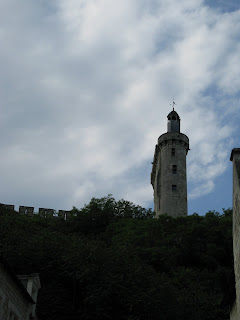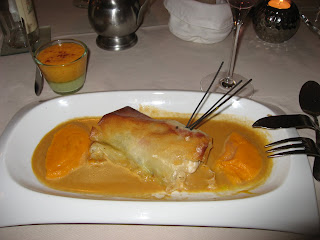The Château de Chinon was an important shrine in Joan of Arc country, wheedling money from all passing pilgrims.
Before that, Chinon was the Plantagenet kings' favourite castle. Although the château is now mostly in ruins, the ramparts are an impressive sight from the opposite bank of the Vienne river.
These flat-bottomed boats are typical of the wooden boats that plied the Loire years ago.
The Tea Ladies would have really enjoyed this.
No Tea Ladies, but Karl and the "Bulldog français" kept me company.

The town's bijou center is like a medieval film set.

Meet "Perchance", a Percheron mare who's only been on the job 3 weeks. Loud motorcycles and big trucks make her skittish. She brought us for a little tour of the town with her driver, Julie.
Press the play button to view the video.

Rue Voltaire, lined with 15th- and 16th-century houses and once enclosed by the castle walls, represents a cross-section of Chinonais history.
At No. 12 is the Musée Animé du Vin, where animated figures tell the story of wine-making.
No. 44 which houses the Musée d'Art et d'Histoire, is a stone mansion where, in 1199, Richard the Lion-Heart is said to have died.
The grandest mansion is the Palais du Gouverneur, with its double staircase and loggia.
More charming is the Maison Rouge in the Grand Carroi, studded with a red-brick herringbone pattern.
The 15th-century Hostellerie Gargantua, where Rabelais' lawyer father once practised, is now an agreeable inn. The great Renaissance writer lived nearby in the Rue de la Lamproie. (Five kilometers southwest of Chinon is La Devinière, birthplace of François Rabelais, the 16th-century writer, priest, doctor, diplomat and humanist scholar known for his wisdom and tolerance. He is best remembered for his many ribald satires written as "medicine" for his patients, such as Pantagruel and Gargantua, set around his native Chinon.)
This "brocante" had many interesting finds. One that intrigued me was a miniature chamber pot with a "winking eye" painted in the bottom. I asked the owner to explain this to me and she said that in days of yore, the bride would have a Tea Party given to her by her lady friends the day after the wedding. One of the gifts was this little chamber pot that was teasingly saying "I know what you've been up to", nudge nudge, wink wink.
We ended our day with a delicious meal at l'Océanic.
There were of course fish dishes since this was a seafood restaurant.
Karl had a cappuccino mousse with macaroon for dessert.
My dessert was unusual since it was a bowl of raspberry coulis covered with "barbe à papa". We know it as cotton candy.
When you poured the remaining coulis on top of the "barbe", it deflated. Very sweet.
~ AM
































No comments:
Post a Comment